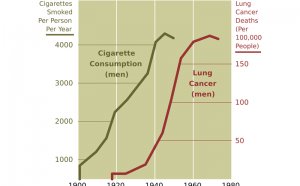
Lung cancer History

Incidence and Mortality
is the second most common cancer and the primary cause of cancer-related death in both men and women in the United States. The overall rate for lung and cancers rose steadily through the 1980s, peaked in the early 1990s, and has been slowly declining since 2001. Trends in lung cancer and mortality rates have closely mirrored historical patterns of smoking prevalence, after accounting for a lag period. Because the prevalence of smoking peaked later in women than in men, lung cancer incidence and mortality rates began declining later for women than men. The incidence rate has been declining since the mid-1980s in men but only since the mid-2000s in women; the mortality rate began declining in 1991 in men and but not until 2003 in women. Incidence and mortality rates are highest among African American men, followed by white men.
Although smoking is the main cause of lung cancer, lung cancer risk also is increased by exposure to ; environmental exposures, such as, workplace (e.g., , ), and air pollution. The risk of lung cancer can be reduced by quitting smoking and by eliminating or reducing exposure to secondhand smoke and environmental and workplace . The National Lung Screening Trial has shown that current or former heavy smokers with low-dose (CT) decreases their risk of dying from lung cancer. Standard treatments for lung cancer include, , , , , , , placement, and .
Assuming that incidence and survival rates follow recent trends, it is estimated that $11.9 billion will be spent on lung cancer care in the United States in 2014.
Source: Surveillance, Epidemiology, and End Results (SEER) Program and the National Center for Health Statistics. Additional statistics and charts are available at the SEER Web site.
NCI’s Investment in Lung Cancer Research
To learn more about the research NCI conducts and supports in lung cancer, visit the NCI Funded Research Portfolio (NFRP). The NFRP includes information about research grants, contract awards, and intramural research projects funded by NCI. When exploring this information, it should be noted that approximately half of the NCI budget supports basic research that may not be specific to one type of cancer. By its nature, basic research cuts across many disease areas, contributing to our knowledge of the underlying biology of cancer and enabling the research community to make advances against many cancer types. For these reasons, the funding levels reported in NFRP may not definitively report all research relevant to a given category.
Source: NCI Funded Research Portfolio. Only projects with assigned common scientific outline area codes are included. A description of relevant research projects can be found on the NCI Funded Research Portfolio Web site.
VIDEO REVIEWS



Share this Post
Related posts
Cigarette smoking and lung cancer
The American Lung Association is concerned about the health impacts of marijuana use, especially on lung health. We caution…
Read MoreLung cancer from smoking
The Abramson Cancer Center of the University of Pennsylvania Last Modified: May 8, 2013 Question Does stopping smoking and/or…
Read More










